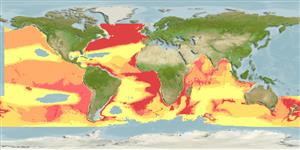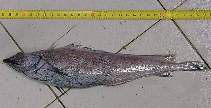Ajouter votre observation dans Fish Watcher
| Native range | All suitable habitat | Point map | Year 2050 |

|
| This map was computer-generated and has not yet been reviewed. |
| Antimora rostrata AquaMaps Data sources: GBIF OBIS |
Envoyez vos Photos et vidéos
Pictures | Videos | Images GoogleAntimora rostrata
Picture by Garazo Fabregat, A.
Pictures | Videos | Images GoogleAntimora rostrata
Picture by Garazo Fabregat, A.
Argentina country information
Common names:
[No common name]
Occurrence: native
Salinity: marine
Abundance: | Ref:
Importance: | Ref:
Aquaculture: | Ref:
Regulations: | Ref:
Uses: no uses
Comments: Occurs in the Patagonian region (Ref. 27363). Also Ref. 3917.
National Checklist: Argentina
Country Information: https://www.cia.gov/library/publications/resources/the-world-factbook/geos/ar.html
National Fisheries Authority:
Occurrences: Occurrences Point map
Main Ref: Cohen, D.M., T. Inada, T. Iwamoto and N. Scialabba, 1990
National Database:
Occurrence: native
Salinity: marine
Abundance: | Ref:
Importance: | Ref:
Aquaculture: | Ref:
Regulations: | Ref:
Uses: no uses
Comments: Occurs in the Patagonian region (Ref. 27363). Also Ref. 3917.
National Checklist: Argentina
Country Information: https://www.cia.gov/library/publications/resources/the-world-factbook/geos/ar.html
National Fisheries Authority:
Occurrences: Occurrences Point map
Main Ref: Cohen, D.M., T. Inada, T. Iwamoto and N. Scialabba, 1990
National Database:
Common names from other countries
Classification / Names Noms communs | Synonymes | Catalog of Fishes(Genre, Espèce) | ITIS | CoL | WoRMS | Cloffa
Environment: milieu / climate zone / depth range / distribution range Écologie
marin bathypélagique; profondeur 350 - 3000 m (Ref. 1371), usually 1200 - 2700 m (Ref. 5951). Deep-water; 70°N - 68°S, 180°W - 180°E
Distribution Pays | Zones FAO | Écosystèmes | Occurrences | Point map | Introductions | Faunafri
Circumglobal: Except the North Pacific north of 10°N. Reported from the Walvis Ridge and near the Discovery and Meteor seamounts (Ref. 44938).
Length at first maturity / Taille / Poids / Âge
Maturity: Lm 42.0, range 41 - 43 cm
Max length : 75.0 cm SL mâle / non sexé; (Ref. 5208); poids max. publié: 3.3 kg (Ref. 128737); poids max. publié: 3.3 kg; âge max. reporté: 44 années (Ref. 128738)
Max length : 75.0 cm SL mâle / non sexé; (Ref. 5208); poids max. publié: 3.3 kg (Ref. 128737); poids max. publié: 3.3 kg; âge max. reporté: 44 années (Ref. 128738)
Description synthétique Clés d'identification | Morphologie | Morphométrie
Épines dorsales (Total) : 0; Rayons mous dorsaux (Total) : 55 - 61; Épines anales: 0; Rayons mous anaux: 36 - 44; Vertèbres: 57 - 60. Blue-grey to blackish (Ref. 6606).
Found on the continental slope and upper rise (Ref. 6606). Epibenthic (Ref. 58426) and benthopelagic (Ref. 5951). Deep waters to 3277 m (Ref. 58426). May move offshore with age and spawn in the deep parts of its range. Off the eastern coast of United States, it is speculated that the population use the area only as feeding grounds with spawning taking place to the north. Feed on benthic invertebrates (Ref. 9319). Maximum weight of female from Ref. 128738.
Life cycle and mating behavior Maturité | Reproduction | Frai | Œufs | Fécondité | Larves
Référence principale
Upload your references | Références | Coordinateur | Collaborateurs
Cohen, D.M., T. Inada, T. Iwamoto and N. Scialabba, 1990. FAO species catalogue. Vol. 10. Gadiform fishes of the world (Order Gadiformes). An annotated and illustrated catalogue of cods, hakes, grenadiers and other gadiform fishes known to date. FAO Fish. Synop. 125(10). Rome: FAO. 442 p. (Ref. 1371)
Statut dans la liste rouge de l'IUCN (Ref. 130435: Version 2024-2)
Préoccupation mineure (LC) ; Date assessed: 11 July 2012
Menace pour l'homme
Harmless
Utilisations par l'homme
Pêcheries: commercial
FAO(pêcheries: production; publication : search) | FIRMS (Stock assessments) | FishSource | Sea Around Us
Plus d'informations
Trophic ecology
Éléments du régime alimentaire
Composition du régime alimentaire
Consommation alimentaire
Food rations
Prédateurs
Éléments du régime alimentaire
Composition du régime alimentaire
Consommation alimentaire
Food rations
Prédateurs
Population dynamics
Paramètres de croissance
Max. ages / sizes
Length-weight rel.
Length-length rel.
Fréquences de longueurs
Mass conversion
Recrutement
Abondance
Paramètres de croissance
Max. ages / sizes
Length-weight rel.
Length-length rel.
Fréquences de longueurs
Mass conversion
Recrutement
Abondance
Life cycle
Reproduction
Maturité
Fécondité
Frai
Spawning aggregations
Œufs
Développement de l'œuf
Larves
Dynamique des populations larvaires
Reproduction
Maturité
Fécondité
Frai
Spawning aggregations
Œufs
Développement de l'œuf
Larves
Dynamique des populations larvaires
Anatomy
Surface branchiale
Brain
Otolith
Surface branchiale
Brain
Otolith
Physiology
Body composition
Nutrients
Consommation d'oxygène
Type de nage
Vitesse de nage
Visual pigments
Fish sound
Diseases & Parasites
Toxicity (LC50s)
Body composition
Nutrients
Consommation d'oxygène
Type de nage
Vitesse de nage
Visual pigments
Fish sound
Diseases & Parasites
Toxicity (LC50s)
Genetics
Génétique
Heterozygosity
Héritabilité
Génétique
Heterozygosity
Héritabilité
Human related
Aquaculture systems
Profils d'aquaculture
Souches
Ciguatera cases
Stamps, coins, misc.
Aquaculture systems
Profils d'aquaculture
Souches
Ciguatera cases
Stamps, coins, misc.
Outils
E-book | Guide de terrain | Clés d'identification | Générateur de fréquences de longueur | Outil de dynamique de population | Carte par point | Classification Tree
| Catch-MSY |
Articles particuliers
Télécharger en XML
Sources Internet
Aquatic Commons | BHL | Cloffa | BOLDSystems | Websites from users | FishWatcher | CISTI | Catalog of Fishes(Genre, Espèce) | DiscoverLife | ECOTOX | Faunafri | Fishtrace | GenBank(génôme, nucléotide) | GloBI | GOBASE | | Google Books | Google Scholar | Google | IGFA World Record | MitoFish | Bases de données nationales | Otolith Atlas of Taiwan Fishes | PubMed | Reef Life Survey | Scirus | SeaLifeBase | Arbre de Vie | Wikipedia(aller à, chercher) | World Records Freshwater Fishing | Zoological Record
Estimates based on models
Preferred temperature (Ref. 115969): 1.9 - 4.6, mean 2.9 (based on 4347 cells).
Phylogenetic diversity index (Ref. 82804): PD50 = 0.7500 [Uniqueness, from 0.5 = low to 2.0 = high].
Bayesian length-weight: a=0.00331 (0.00267 - 0.00411), b=3.15 (3.08 - 3.22), in cm Total Length, based on LWR estimates for this species (Ref. 93245).
Niveau trophique (Ref. 69278): 3.6 ±0.47 se; based on food items.
Résilience (Ref. 120179): Très faible, temps minimum de doublement de population supérieur à 14 ans (K=0.05-1.0; tm=15; tmax=44).
Fishing Vulnerability (Ref. 59153): High to very high vulnerability (70 of 100).
Climate Vulnerability (Ref. 125649): Moderate vulnerability (38 of 100).




